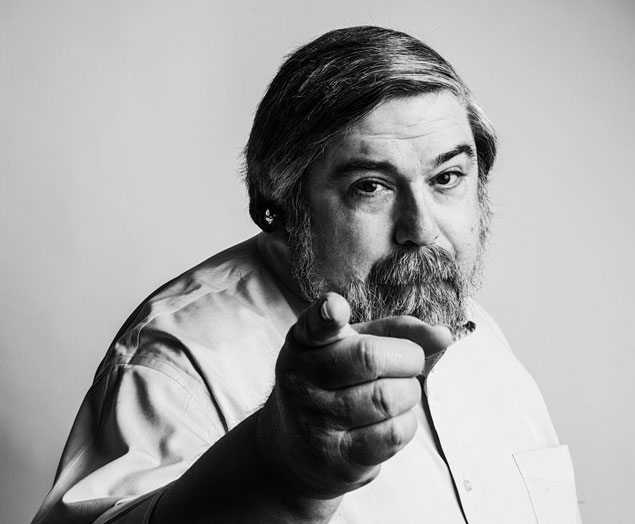“Mark, when was President Obama’s last full news conference?”
asks a reporter from Reuters who, apparently on deadline, has just popped
into the cramped press booth Mark Knoller shares with two colleagues from
CBS News in the back of the White House Press Room.
“March 6, 2012,” Knoller says without looking up from his
computer screen as he updates his Twitter feed. “It was 44 minutes long.
It was in the briefing room.”
Knoller explains that although Obama held his first
post-election news conference this afternoon, November 14, none of his
interactions with reporters since March 6 count as a full-on news
conference. They can only be described as limited question periods,
unscheduled appearances in the briefing room, or impromptu exchanges. The
Reuters reporter doesn’t ask, but Knoller could tell him exactly how many
of those there were.
“Okay, March 6,” the reporter says. “That’s what we’ll go with.
We’re counting on you.”
I turn to Knoller, who is typing a tweet while listening to
three evening news broadcasts from a bank of TVs above his desk. “Do you
get a lot of questions like that?” I ask.
He chuckles softly and shrugs, as if to say, “You think anyone
else keeps track of this stuff?”
• • •
No one does—not in such comprehensive detail. Not in the White
House press corps and not on the White House staff, either. Which explains
why a steady stream of reporters, presidential staffers, and even press
secretaries have routinely e-mailed or dropped in on Knoller for the past
16 years seeking facts about the daily life of the President of the United
States.
Knoller—who reports for CBS on the Web, radio, and occasionally
TV—is the unofficial records keeper of the presidency, the statistics
savant of 1600 Pennsylvania Avenue. Nearly every day, he logs every
movement, act, and utterance of the commander in chief in an obsessively
detailed archive of text files and spreadsheets.
Ask Knoller the most obscure or mundane point of presidential
trivia and he’ll have an answer in seconds. You could start with the easy
stuff, like public appearances. As of my meeting with Knoller, Obama had
made 1,818 speeches, remarks, and public comments as President, using a
Teleprompter 689 times.
But then pick something harder. What does the President do in
his downtime? Well, since taking office, Obama had played 106 rounds of
golf, 50 of them on the course at Joint Base Andrews, home of Air Force
One—on which, by the way, Obama had flown 827 times. Knoller has similar
stats on George W. Bush and a partial record for Bill Clinton.
You could get personal. How often have the President and Mrs.
Obama hit the town? The First Couple has dined out at restaurants 18
times, including date nights in Washington, New York City, Paris, Martha’s
Vineyard, and Hawaii.
I finally stump Knoller when I ask if he has any information
about Obama’s dog.
“Sorry, no numbers on Bo,” he says.
I had wondered if Knoller could tell me how many times Bo had
flown on Marine One, the President’s helicopter. Knoller doesn’t know, but
he says Obama has flown aboard 791 times, of which 250 were departures
from the White House.
Knoller is often a more authoritative and responsive source of
information than anyone on the President’s staff. While preparing for an
interview with George W. Bush in 2007, Scott Pelley, the 60
Minutes correspondent and anchor and managing editor of the CBS
Evening News, asked Knoller how many days the President had spent at
Camp David.
“Three hundred sixty-five,” Knoller said.
“Really?” Pelley asked. “A whole year? Can’t be.”
“It’s 365 as of last weekend,” Knoller affirmed, “but I’ll
check if you insist.” Knoller did. He was correct.
Knoller broke Pelley in at the White House in the late ’90s,
back when Pelley says he was “a green correspondent who couldn’t find my
way from the Rose Garden to the Oval Office. Every word I said, everything
I did, I checked with Mark first. I could ask Mark
anything—anything—about the Presidents he’s known, and he either
had the answer off the top of his head or in the bottom of a
file.”
• • •
The file Pelley speaks of is actually a collection of about a
hundred Microsoft Word documents and one Excel spreadsheet—in which he
logs all of President Obama’s press interviews—that Knoller updates at the
end of each day, around 7 o’clock, after most of the other reporters have
gone home. The records have importance beyond tracking the President’s
ceremonial duties.
Knoller knows how many fundraisers Obama held in this past
election cycle (220 as of October 11), how many people attended, and the
ticket prices. He keeps track of how many times the President visits each
state—an illuminating statistic during the campaign. Obama made 22 visits
to Ohio, by Knoller’s count, and focused the majority of his visits on
just nine states. The record confirmed, and likely informed, what every
campaign journalist reported from the trail: that the President, like his
opponent, focused almost all his attention on a handful of battlegrounds,
to the general exclusion of the rest of the country.
“Just by looking at that,” Knoller says, pointing to his tally,
“you see what his strategy was. I don’t have to be spun [by presidential
campaign staff]. I have my own tactical playbook on the
President.”
But as he scans through the archive, I understand why Knoller
is the only person keeping such records—it’s hard to imagine anyone else
having the discipline for such an undertaking, or even the
interest.
“You back this stuff up, right?” I ask.
“For years I didn’t,” he confesses. “Now I use this.” He shows
me a hand-held portable hard drive, to which he copies the records so he
can take them on trips. I’m unnerved to learn that the data-redundancy
system for the most extensive and useful archive of presidential activity
of the past 16 years relies on an easily misplaced device that Knoller
carries in a satchel.
“Do you store anything in the cloud?” I ask.
“What’s the cloud?”
I pause, wondering how I might persuade him to try it. “It’s
like using someone else’s hard drive as a safeguard. You know, it’s out
there . . . in the cloud.”
He looks aghast.
“No!” he says. “This stays with me.”

Knoller took up his one-man mission out of frustration. In
1996, Bill Clinton was making another in a series of trips to California,
and Knoller wanted to know how many times he’d visited the state as
President. There was no single, easily accessible source to answer his
question. So Knoller built one. He started with news articles, pulled from
LexisNexis, Facts on File, and some official White House sources. From
there he built his repository entirely through his own reporting and that
of his White House press cohort—entry by entry, log by log, day by
day.
What Knoller Knows
A sampling of the statistics Mark Knoller has gathered on President Obama, as of November 29, 2012.
-
1,819 Speeches, remarks, and comments
-
689 Times he used a Teleprompter
-
105 Press availabilities
-
20 Formal White House news conferences
-
106 Rounds of golf
-
791 Flights on Marine One
-
18 Date nights for President and Mrs. Obama
-
38 Basketball games (includes only those played outside the White House)
-
126 Meetings with foreign leaders
-
25 Trips overseas
-
35 Countries visited
Knoller spends about 90 minutes each workday combing through
the President’s schedule, transcripts, and pool reports, distilling the
day into a factual record. He adds short explanations about what was in
the news that day, putting the official tick-tock into some context. “I’m
writing this with the idea that I might go back and read this two years
from now,” he says.
He performs this ritual at least five days a week, often seven.
“The only way to do this is to do it contemporaneously, otherwise you’ll
miss something,” he says. “I’m sure there are errors in the logs. But
they’re as close to perfect as I can make them.”
Knoller is famous for keeping tabs on how much R&R
Presidents take—a figure often used by a chief executive’s critics to
accuse him of slacking off. (Knoller doesn’t like the word “vacation”
because it implies some cessation of official duties, which, for the
President, a holiday never entails.) Once, at a White House Christmas
party, Knoller was introduced to First Lady Laura Bush by her husband as
“the guy who keeps track of how much time we spend in Texas.” Knoller
tells me that in the past year, he himself took a week’s vacation, with a
friend, to Las Vegas and San Francisco. But every night he went through
the pool report and updated his records.
“I couldn’t do this much work if I had a family,” says Knoller,
who is single and lives in Chevy Chase.
“Do you ever wish you had a family?” I ask.
He smiles. “Nah.”
• • •
Knoller, who is 60, grew up in Brooklyn and graduated from New
York University. He started his career as an intern and copy boy at WNEW
radio in New York, then worked his way up to weekend reporter. In 1975, he
took a job with AP Radio in Washington, staying 13 years before heading to
CBS News. He has covered every President since Gerald Ford.
The reporters who rely on Knoller’s data trove know little
about his life. “He’s very hard to pin down on anything personal,” says
CBS News correspondent Bill Plante, who joined the network in 1964 and has
sat next to Knoller in the tiny White House booth for 20 years. “He’s very
private. He’s not very social—by choice. Around the White House, the
personality he likes to project is a curmudgeon.”
But Knoller’s gruffness is belied by his generosity. He shares
what he knows with anyone who asks. He shows me e-mails from journalists
at Politico, Yahoo!, and the Huffington Post, all of whom need a
fact checked or a number filled in and who end their harried missives with
effusive expressions of thanks.
“It does me no good to keep all of this stuff to myself,”
Knoller says.
He also dispenses his factoids to more than 118,000 followers
on Twitter. The social network has become Knoller’s front page, his
private news channel: “It has made me a wire service unto myself.” He says
he loves not having to submit his copy to an editor.
And surprisingly for a man with a very private private life,
he’s delighted that Twitter has made him publicly recognizable. Knoller’s
face, prominently displayed on his Twitter feed, is unmistakable: bushy
hair, beard, and sideburns—he’d make a good Civil War reenactor. Sober
eyes bordering on sad.
“It’s amazing,” Knoller says. “Thirty years of doing radio, no
one knows who you are. Now people come up to me and say, ‘I read your
tweets all the time!’ It makes me feel good.”
Knoller appreciates the attaboys, but he seems less interested
in credit, particularly from the other reporters who make regular use of
his labor.
“Will they mention you in their stories?” I ask.
“Maybe,” Knoller says. He doesn’t appear too concerned. Some
do, some don’t. A lot of reporters don’t like to cite their colleagues.
But Knoller has rarely asked for a shout-out. The possession of special
knowledge comes with its own rewards.
“Do you like being the only one who knows all this?” I
ask.
A sheepish grin creeps across Knoller’s face. “Yeah,” he says,
nodding, and turns back to his Twitter feed.
This article appears in the January 2013 issue of The Washingtonian.



















